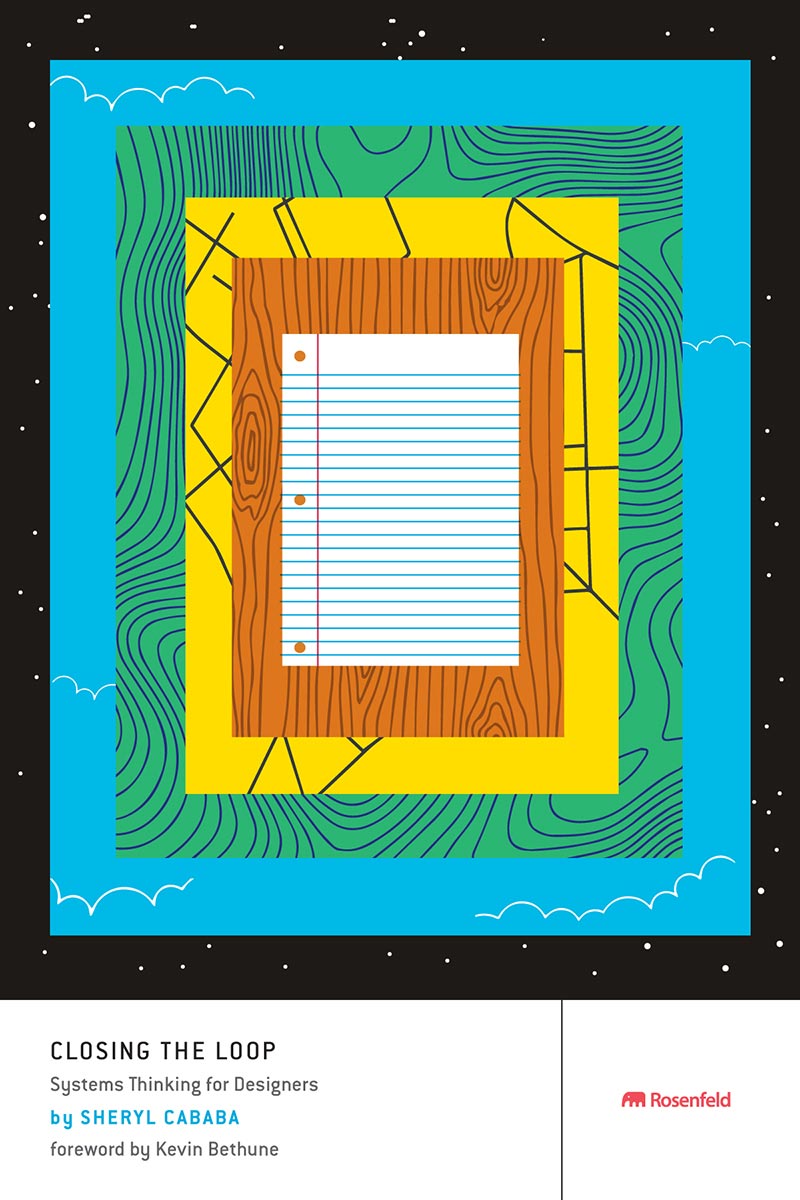Contents
CLOSING THE LOOP
SYSTEMS THINKING FOR DESIGNERS
Sheryl Cababa
NEW YORK 2023
Design helps people by offering thoughtful solutions, which can also bring unintended consequences. Sheryls book urges us to broaden our perspective and provides valuable guidance to bring in to daily practice.
Hung-Hsiang Chen,
Head of UX & HF at ConvaTec
Cababas book comes at a crucial moment for design, and points the way toward a more inclusive, meaningful future for our work.
David Dylan Thomas,
author, Design for Cognitive Bias
Cababa reminds us of what design was intended to be: a force for positive impact. Through relatable examples and frameworks for thinking plus doing, this book is a guide for designers to practice the design we all want.
Masuma Henry,
Design Director, Google
As an anthropologist, I know the value of bringing a systems perspective to designing for change. Sheryls book is a thoughtful guide for designers seeking to bring more systems thinking to their craft.
Tracy Pilar Johnson,
Design Anthropologist, Bill & Melinda Gates Foundation
More than ever, designers are poised to play higher-impact roles. Sheryl Cababa reveals how systems thinking will be the powerful new skill to get us there.
Brandon Schauer,
Rare.orgs leader of Climate Culture
This is a must-have book for practitioners developing products and services at every level.
Jose Coronado,
Executive Director Digital Experience Design, JP Morgan Chase
Cababa provides a fresh perspective on how design research and practice can meet the needs of a complex and sometimes contentious 21st century.
Beth Kolko, Professor,
University of Washington
In her comprehensive, insightful, and actionable guide, Sheryl Cababa draws from real-time and historical global events, expert insights from across industries, and her depth of expertise, challenging us to use systems thinking to shift our own perspectives and assumptions about how to envision and design for a better future.
Kristin Skinner,
Chief Experience Officer at &GSD and
co-author Org Design for Design Orgs
Closing the Loop
Systems Thinking for Designers
By Sheryl Cababa
Rosenfeld Media
125 Maiden Lane
New York, New York 10038
USA
On the Web: www.rosenfeldmedia.com
Please send errata to:
Publisher: Louis Rosenfeld
Managing Editor: Marta Justak
Interior Layout: Danielle Foster
Cover Design: Heads of State
Indexer: Marilyn Augst
Proofreader: Sue Boshers
2023 Sheryl Cababa
All Rights Reserved
ISBN: 978-1-959029-88-5
ISBN 13: 1-959029-88-6
LCCN: 2022943944
Printed and bound in the United States of America
For Rebecca and Ernesto, who always supported my curiosity
HOW TO USE THIS BOOK
Who Should Read This Book?
This book is for practitioners who want to incorporate systems-thinking methods into their practice. Design researchers, strategists, and experience designers, as well as those from domains such as technology, healthcare, education, and other spaces in which human-centered design is often incorporated, will benefit from this books tools and instruction that help broaden perspectives.
Whats in This Book?
This book includes the rationale for incorporating systems thinking into your design practice. Youll find examples and stories that support that rationale, as well as interviews with experts who engage with systems thinking in their own practice. In order to make the systems-thinking perspective accessible and actionable, youll also find practical tools and frameworks that you can include in your practice right away. Prompts, examples, and advice about how to use those tools will help facilitate their use.
This book is designed in three parts. In , you will learn about tools and methods for envisioning the future.
Within the various chapters, youll find some common elements:
System Spotting: Throughout the book, Ive included sidebars that are examples of visible systems. These sidebars have events, objects, symbols, and words that you might see in your own cities, in the news, history, or the language that you use. They are good exercises in determining what patterns, structures, and mindsets sit beneath the events you experience and the things you see in the world.
Interviews: I end many chapters with an interview with an expert design practitioner who engages in systems thinking. I admire and have learned from each of them, and they each have inspiring ways to think about systems, concepts that drive their practice, and tools that you can likely use as well.
This is your plastic hour. From digital technology to global health, you, as a designer, have already been problem-solving in ways that are great and small. By using systems thinking, you can shift your perspectives and assumptions about what you should design and why. Finally, youll have a chance to build upon your skills to create an even greater impact. I hope these tools, frameworks, and approaches will help you facilitate that shift.
What Comes with This Book?
This books companion website ( https://rosenfeldmedia.com/books/systems-thinking-for-designers/ ) contains a blog and additional content. The books diagrams and other illustrations are available under a Creative Commons license (when possible) for you to download and include in your own presentations. You can find these on Flickr at www.flickr.com/photos/rosenfeldmedia/sets/ .
https://rosenfeldmedia.com/books/systems-thinking-for-designers/ ) contains a blog and additional content. The books diagrams and other illustrations are available under a Creative Commons license (when possible) for you to download and include in your own presentations. You can find these on Flickr at www.flickr.com/photos/rosenfeldmedia/sets/ .
FREQUENTLY ASKED QUESTIONS
What do you mean by systems thinking?
This is a very good question because youd be surprised at how many different answers there are to this question. For example, there are ideas and practices oriented around hard systems methodology, which is focused primarily on finding and enacting efficiencies within a given system. This includes approaches such as systems engineering.
In this book, your main concern will be oriented around soft systems methodology, which can be described as understanding a problem space, creating a holistic view of it, and considering where intervention can happen to create certain outcomes.
I feel intimidated by systems thinking as a practice. Can I really use systems thinking as a designer?
Designers sometimes tell me that they feel like systems thinking requires complex software to be able to model causal loop maps and simulate how systems will change. This often feels like a barrier to being able to engage.
The tools that are the focus of this book mostly involve various forms of visual mapping. If you, as a designer, use outputs such as user journeys, service blueprints, or other forms of mapping as analysis, then this approach should resonate with, and feel accessible, to you. You do not need complex software to engage in the mindset of systems thinking and make it actionable in your process. It could be helpful to engage with experts in systems analysis if thats what your project work requires, but I do not view it by any means as a necessity. As you grow as a systems-thinking-oriented designer, your practice might shift to involve different tools and collaborations with other experts, but this is not a requirement from the beginning.













 https://rosenfeldmedia.com/books/systems-thinking-for-designers/ ) contains a blog and additional content. The books diagrams and other illustrations are available under a Creative Commons license (when possible) for you to download and include in your own presentations. You can find these on Flickr at www.flickr.com/photos/rosenfeldmedia/sets/ .
https://rosenfeldmedia.com/books/systems-thinking-for-designers/ ) contains a blog and additional content. The books diagrams and other illustrations are available under a Creative Commons license (when possible) for you to download and include in your own presentations. You can find these on Flickr at www.flickr.com/photos/rosenfeldmedia/sets/ .